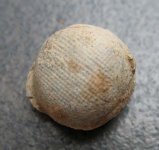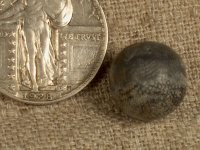pjroo33
Hero Member
- Oct 28, 2007
- 631
- 90
- Detector(s) used
- Minelab CTX 3030, XP Deus, Minelab Explorer II
- Primary Interest:
- All Treasure Hunting
Found this along with a few other musket balls. This one looks like it has an indention of mesh around the outside. Can you tell me what that might be?




 ) a piece of linen?
) a piece of linen?






